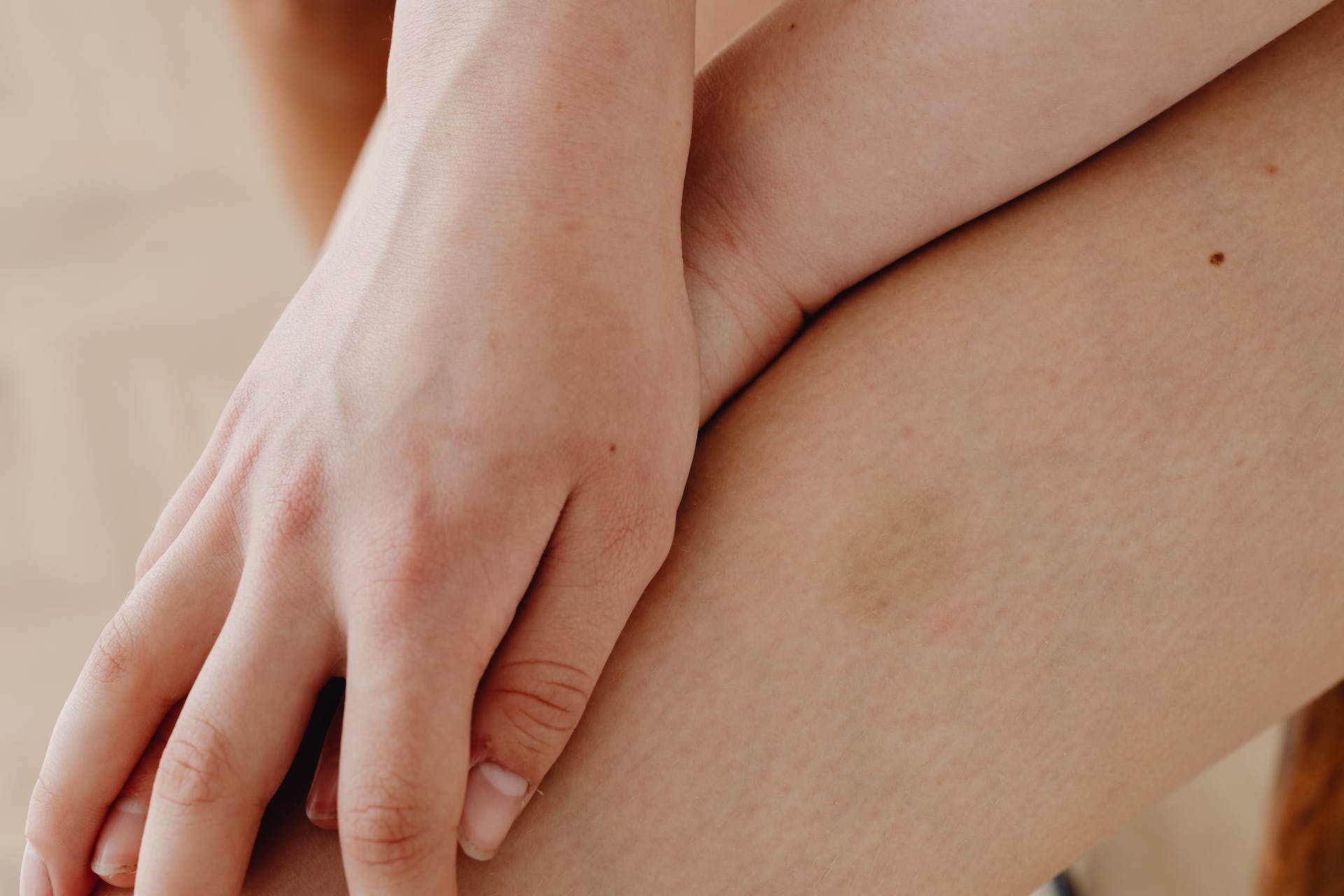
A boil on inner thigh, known as a furuncle, can be a distressing skin infection, particularly for females. These painful, red, swollen bumps are primarily caused by Staphylococcus aureus bacteria and can occur due to various factors, including friction, poor hygiene, hormonal changes, and more.
In this article, we’ll explore seven key takeaway points, answer seven frequently asked questions, and provide guidance on how to manage and prevent boils on the inner thigh.
Key Takeaways
- Probable Causes: Boils on the inner thigh in females can result from factors like bacterial infections, friction, poor hygiene, sweat, ingrown hairs, weakened immune systems, hormonal changes, and personal habits like squeezing or popping pimples.
- Treatment: Managing a boil involves warm compresses, maintaining good hygiene, using antibacterial ointments, pain management with over-the-counter medications, and avoiding squeezing or popping the boil.
- Medical Intervention: If the boil is large, extremely painful, or doesn’t improve with home care, consulting a healthcare professional is necessary. They may perform incision and drainage and prescribe antibiotics if needed.
- Prevention: Preventing future boils includes practicing good personal hygiene, avoiding tight clothing, being cautious about activities that cause friction, and using antibacterial soap during showers.
- Avoid Popping: Popping a boil at home is discouraged, as it can lead to secondary infections, scarring, and the spread of the infection.
- Pregnancy Considerations: Pregnant individuals should consult their healthcare provider when dealing with a boil. Topical treatments, pain management options, and preventative measures should be discussed.
- Home Remedies: Mild cases of boils can be managed with home remedies like warm compresses, tea tree oil, turmeric paste, Epsom salt soaks, onion poultices, garlic clove application, aloe vera gel, warm baths with essential oils, and over-the-counter pain relievers.
Boil on Inner Thigh in Females
A boil, medically known as a furuncle, is a skin infection caused by Staphylococcus aureus. Boils typically begin as a painful, red, swollen bump on the skin, which eventually fills with pus. When they develop on the inner thigh near the groin in females, they can be particularly painful due to the sensitive nature of the area. These infections are more common in adults than children.
Probable Causes of Boil on Inner Thigh
A boil on the inner thigh near the groin in females, also known as a furuncle, can be caused by various factors, including:
- Bacterial Infection: Boils are primarily caused by the bacterium Staphylococcus aureus. This bacterium commonly resides on the skin and can enter hair follicles through small cuts, scrapes, or other openings. Once inside the follicle, it can multiply, leading to inflammation and the formation of a boil. Staphylococcus aureus produces enzymes and toxins contributing to tissue damage and abscess formation within the hair follicle.
- Friction or Chafing: Excessive friction and rubbing between the thighs can cause irritation and microtrauma to the skin. This irritation can create a favorable environment for bacteria to invade the hair follicles and lead to the development of boils.
- Poor Hygiene: Insufficient personal hygiene can allow the accumulation of dirt, sweat, and bacteria in the groin area. Poor hygiene practices may result in an increased risk of bacterial infections, including boils.
- Sweat and Humidity: Excessive sweating, especially in the warm and humid environment of the groin area, can create a moist and favorable condition for bacteria to thrive. Bacteria thrive in moist environments, and this can contribute to the development of boils.
- Ingrown Hairs: When hair follicles become blocked by dead skin cells or other debris, it can lead to ingrown hairs. These ingrown hairs can become infected, providing a breeding ground for bacteria and the formation of boils.
- Weakened Immune System: A compromised immune system, such as in individuals with diabetes or other chronic illnesses, can reduce the body’s ability to fight off infections. This can make them more susceptible to skin infections, including boils.
- Hormonal Changes: Hormonal fluctuations, particularly during menstruation, can affect the skin’s oil production and composition. These changes can make the skin more prone to clogging and infection, contributing to the formation of boils.
- Personal Habits: Picking or squeezing pimples, ingrown hairs, or boils can introduce additional bacteria to the affected area. This can worsen the infection and lead to larger and more painful boils.
Also Read: Last-Minute Solutions: How to Stop Your Period for a Night
How to Treat a Boil on Inner Thigh Near Groin?
Treating a boil on inner thigh near the groin area involves a combination of at-home care and, in some cases, medical intervention. Here are the steps to treat a boil effectively:
- Warm Compresses:
- Begin with warm compresses by soaking a clean washcloth or cotton ball in warm (not hot) water and gently apply it to the boil for 10-20 minutes, 3-4 times a day.
- The heat helps increase blood flow to the area, encourages the boil to come to a head, and can provide some pain relief.
- Keep the Area Clean:
- Maintain good hygiene by washing the affected area with mild soap and warm water. Avoid scrubbing the boil to prevent further irritation.
- Change clothing and undergarments regularly to prevent the spread of bacteria.
- Use Antibacterial Ointment:
- After cleaning the area, apply an over-the-counter antibiotic ointment to the boil. This can help prevent the infection from spreading.
- Pain Management:
- Over-the-counter pain relievers like ibuprofen or acetaminophen can help alleviate pain and reduce inflammation.
- Avoid Squeezing or Popping:
- Never attempt to squeeze or pop a boil, as this can worsen the infection and lead to complications.
- Watch for Signs of Improvement or Complications:
- Most boils will eventually drain and heal on their own with proper care. However, if the boil worsens, spreads, or doesn’t improve within a week, consult a healthcare professional.
- Medical Intervention:
- If the boil is large, extremely painful, or does not improve with home care, it may require medical attention. A healthcare provider may need to drain the boil using a small incision and prescribe antibiotics if the infection has spread.
- In some cases, a healthcare professional may recommend a procedure called “incision and drainage,” in which they numb the area, make a small cut to allow the pus to drain, and clean the wound.
- Prevent Future Boils:
- To prevent recurrent boils, maintain good personal hygiene, especially in the groin area. Avoid tight-fitting clothing, and be mindful of activities that may cause friction or chafing.
- Consider using an antibacterial soap during showers and avoid sharing personal items that may harbor bacteria.
It’s important to be patient, as it may take several days for a boil to fully heal. If you have a compromised immune system or other underlying health conditions, it’s particularly important to seek medical advice early. Always consult a healthcare professional if you have concerns about a boil, as they can provide the most appropriate guidance and treatment.
What If My Boil Popped?
Popping a boil at home is discouraged, as it can lead to complications such as:
-
- Secondary Infection: Squeezing a boil can introduce more bacteria and lead to a secondary infection.
- Scarring: Improperly popping a boil can result in scarring.
- Spread of Infection: Squeezing the boil can cause the infection to spread to adjacent areas.
If your boil has popped, it means that the built-up pus and infectious material within the boil has drained out on its own. This can be a natural part of the healing process. Here’s what you should do if your boil has popped:
- Keep the Area Clean: Gently clean the area around the popped boil with mild soap and warm water to remove any pus and debris. Use a clean, soft cloth or sterile gauze.
- Apply an Antibacterial Ointment: After cleaning, apply an over-the-counter antimicrobial ointment like Neosporin to the area. This can help prevent further infection and promote healing.
- Cover with a Bandage or Dressing: Place a clean bandage or sterile dressing over the popped boil to protect it from further contamination and to keep the area clean.
- Change Dressings Regularly: Change the bandage and reapply antibiotic ointment several times a day. This will help keep the area clean and prevent it from sticking to the bandage.
- Wash Hands Thoroughly: Always wash your hands thoroughly before and after touching the affected area to prevent the spread of bacteria.
- Dispose of Materials Properly: Dispose of used bandages and dressings in a sealed plastic bag to prevent others from coming into contact with potentially infectious materials.
- Monitor for Signs of Infection: Keep a close eye on the area. If it becomes increasingly red, swollen, painful, or shows signs of spreading infection, consult a healthcare professional promptly.
- Avoid Squeezing or Popping: Do not try to squeeze or pop the boil if it hasn’t completely drained, as this can introduce more bacteria and potentially worsen the infection.
- Pain Management: Over-the-counter pain relievers can help manage any pain or discomfort associated with the popped boil.
- Seek Medical Attention: If the boil is large and extremely painful, or if you suspect the infection has spread, it’s advisable to consult a healthcare professional. They may need to assess the wound and determine if further treatment, such as incision and drainage, is necessary.
What If I am Pregnant?
If you are pregnant and develop a boil on your inner thigh near the groin area, it’s important to take some precautions and seek medical advice, as pregnancy can affect your body’s immune response and may influence how you can manage the boil. Here are some considerations and steps to take:
- Consult Your Healthcare Provider: As soon as you notice the boil, it’s a good idea to contact your obstetrician or midwife. They can provide specific guidance based on your individual health and the stage of your pregnancy.
- Avoid Self-Treatment: Do not attempt to pop or lance the boil yourself, as this can increase the risk of infection and complications. Let your healthcare provider assess the situation and determine the best course of action.
- Topical Treatments: Your healthcare provider may recommend or prescribe topical treatments, such as antibiotics or antiseptic ointments, that are safe to use during pregnancy. Always follow their guidance when using any medications.
- Pain Management: If the boil is causing discomfort, your healthcare provider can recommend pregnancy-safe pain relief options. Avoid using any medications without their approval.
- Monitor for Signs of Infection: Keep a close eye on the boil for any signs of spreading infection, such as increased redness, swelling, or fever. Report these symptoms to your healthcare provider immediately.
- Preventative Measures: Discuss any lifestyle changes or preventative measures with your healthcare provider, such as avoiding tight clothing, minimizing friction, and keeping the area clean.
Also Read: Benadryl During Pregnancy: Allergies, Zzz’s, and Beyond
What are Home Remedies for Managing Boils?
Home remedies can help in treating and managing a boil on the inner thigh near the groin in females, especially when the condition is mild. Here are some effective home remedies to consider:
- Warm Compresses: Apply a warm, moist compress to the boil for 10-15 minutes, several times a day. This can help the boil come to a head, drain, and reduce pain. Use a clean, soft cloth or sterile gauze soaked in warm water.
- Tea Tree Oil: Tea tree oil has natural antibacterial properties. Dilute a few drops of tea tree oil in a carrier oil like coconut oil, and apply it to the boil using a cotton ball. Be cautious not to use undiluted tea tree oil, as it can be irritating.
- Turmeric Paste: Turmeric has anti-inflammatory and antimicrobial properties. Make a paste by mixing turmeric powder with a small amount of water, and applying it to a boil. Cover it with a bandage.
- Epsom Salt Soaks: Add a few tablespoons of Epsom salt to warm bathwater and soak in it. Epsom salt can help reduce pain and promote healing.
- Onion Poultice: Apply a poultice made from a sliced onion to the affected area. Onions have natural antimicrobial properties and can help draw out the pus.
- Garlic Clove: Crush a garlic clove and apply it to a boil, then cover it with a clean cloth. Garlic has antimicrobial properties and may help with infection.
- Aloe Vera Gel: Apply aloe vera gel, known for its soothing and anti-inflammatory properties, to the affected area. Ensure you are using pure aloe vera gel.
- Warm Bath with Essential Oils: Taking a warm bath with a few drops of essential oils like lavender or chamomile can provide relaxation and promote healing.
- Over-the-Counter Pain Relievers: Non-prescription pain relievers like acetaminophen or ibuprofen can help manage pain and reduce inflammation. Ensure they are safe for you based on your medical history and any pregnancy considerations.
- Seeking Medical Advice: If you notice signs of worsening infection, it’s essential to consult a healthcare professional for a proper evaluation and potential medical treatment. Additionally, pregnant women should consult their healthcare provider before using any home remedies or over-the-counter treatments.
Final Thoughts
FAQs
- Q: What causes boils on the inner thigh in females?
- A: Boils can be caused by bacterial infections, friction, poor hygiene, sweat, ingrown hairs, weakened immune systems, hormonal changes, and personal habits like squeezing or popping pimples.
- Q: How can I treat a boil on my inner thigh?
- A: Treatment involves warm compresses, maintaining good hygiene, using antibacterial ointments, pain management with over-the-counter medications, and avoiding squeezing or popping the boil.
- Q: When should I seek medical intervention for a boil?
- A: If the boil is large, extremely painful, or doesn’t improve with home care, it’s advisable to consult a healthcare professional for assessment and potential treatment.
- Q: Can I pop a boil at home?
- A: Popping a boil at home is discouraged, as it can lead to secondary infections, scarring, and the spread of the infection.
- Q: What should I do if my boil has popped on its own?
- A: Clean the area, apply an antibacterial ointment, cover it with a bandage, change dressings regularly, monitor for signs of infection, and avoid squeezing or popping.
- Q: How should pregnant individuals manage boils on the inner thigh?
- A: Consult your healthcare provider for guidance on treatment, topical treatments, pain management, and preventative measures during pregnancy.
- Q: What are some home remedies for managing boils on the inner thigh?
- A: Home remedies include warm compresses, tea tree oil, turmeric paste, Epsom salt soaks, onion poultices, garlic clove application, aloe vera gel, warm baths with essential oils, and over-the-counter pain relievers.
#Boils #SkinInfection #Furuncle #InnerThighBoil #Healthcare #Treatment #Prevention #HomeRemedies #WomensHealth #Hygiene #InfectionControl #MedicalAdvice #PregnancyHealth #SkinCare #HealthyLiving
Note: The information provided in this article is for educational purposes only and should not be taken as medical advice. For personalized health recommendations, it is always advisable to consult with a healthcare professional before incorporating any changes to your daily health routine.








No comment yet, add your voice below!